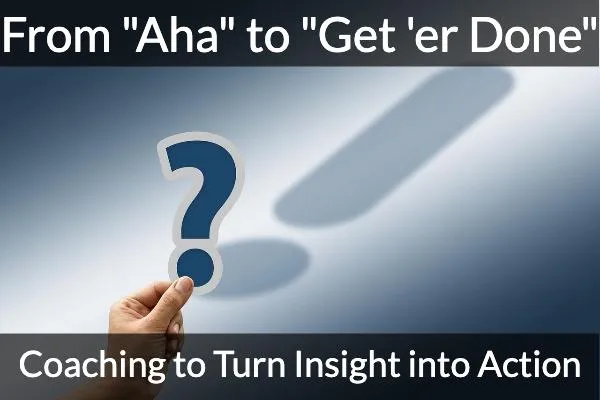
Aha to Action
The Mindset Mastery Memo is for ambitious professionals who want to lead with clarity, calm, and confidence. Each edition offers practical tools, mindset shifts, and real-world examples to help you navigate pressure, build stronger teams, and break free from patterns that no longer serve you—so you can lead with intention, not reaction.
Great coaching doesn’t end with an “aha.” Once a team member sees a fresh possibility, your role shifts to helping them convert insight into traction.
Now your job is to guide your employee through three separate tasks:
Identify Options
Choose an Option
Commit
This sequence is designed very deliberately to preserve ownership, grow capability, and build emotional courage through small, safe experiments.
And from experience, I can tell you that it's extremely tempting to skip steps 1 and 3. But doing so is generally a mistake.
Task 1: Identify Options
Start by generating multiple ways forward. Insist on at least three possibilities; more is better. Quantity matters because it stretches creativity and reduces the odds of premature convergence on a single, habitual fix. To loosen thinking:
Lower the bar for success. Invite “one‑in‑a‑million schemes” and “outlandish escapades.” Bad ideas are welcome; they often spark good ones.
Use constraint‑busting questions. “What would you try if budget were unlimited?” or, conversely, “If you had to solve this with no money at all?” These what‑ifs jolt the mind past self‑imposed limits.
Surface past attempts. Ask what’s already been tried—successes and failures alike. Previous experience can be repurposed or inverted to suggest new avenues.
Throughout this step, remind the employee that you’re compiling a list, not making a judgment. Keeping evaluation out of the brainstorming phase prevents the inner critic from shutting ideas down prematurely.
It's tempting to skip this step because generating that first positive option feels so good. They've been stuck and now they're unstuck. They've been down and now they're up. They've been confused and now they're clear. They've been defensive and now they're proactive.
But you're not harshing their vibe by pushing for additional options. You're not peeing on their parade, or dragging them back down into doubt-and-fear-land. Instead, you're signaling your confidence in their ability to stay engaged and creative, rather than slip back into old, disempowered mindsets.
Task 2: Choose the Path Forward
With options on the table, guide your employee to select a workable experiment. The aim is not perfection; it’s a plan that has a reasonable chance of success and from which they can learn and improve. Two disciplines make the choice robust:
Risk–reward calibration. Discuss the upside of each option along with potential downsides. Encourage the person to weigh effort and likely impact before deciding. Are there hidden pitfalls? Secondary gains? Unintended consequences? How will others likely respond? Who are the shadow stakeholders here? Who else needs to be brought into the loop?
This inquiry builds your employee's strategic muscle, and encourages them to think a few moves ahead in the chess game of life.
Level‑10 confidence test. Once they land on a preferred action, ask: “On a scale of 1 to 10, how confident are you that you will carry this out?” Anything below 8 signals hidden obstacles. Break the step into smaller rungs, add resources, or rehearse tough moments until the answer rises to 10—or as close as reality permits.
This simple rating surfaces practical and emotional barriers early, when they’re easiest to mitigate.
Task 3: Commit to Specific Actions
The last task is to lock the choice into a visible, time‑bound commitment—“what, how, and when.” Effective commitments share three characteristics:
Observable deliverable. Spell out precisely what will exist or occur. “Talk to Ramona by end of day” beats “connect with Ramona soon.”
Trigger clarity. For ongoing or event‑driven behaviors, use a When/Then formula: When [trigger], then I will [behavior]. Example: “When a meeting drifts off agenda, then I will ask to restate the goal.”
Self‑accountability, not policing. Managers should avoid the hall‑monitor trap. Ask for the commitment, document it where both parties can see it, and trust the employee to honor their word. Accountability flows to the plan and the outcome—not to you.
After the details are nailed down, double‑check confidence one final time. If it still isn’t a solid 10, explore what extra support—resources, rehearsal, emotional preparation—would close the gap.
It's tempting to skip this step because it can feel like babysitting. After all the bright and clever ideation, you might be reluctant to ask your employee to delineate the exact steps they're going to take. Especially if it's a senior person, you might worry that they'll resent your micromanaging.
As a coach, I do sometimes skip this step — but only with clients who are relentless in execution and whose word to themselves is bond. If you have any doubts about whether the plan will get done, and not deprioritized the moment the next whack-a-mole crisis pops up, then you're doing everyone a favor by gently insisting on specificity and accountability.
Putting It All Together
The framework is deliberately experimental. Each cycle ends with a review.
Did you do what you said you would? If so, how did it go? What happened? What did you learn? What's next?
Did you not execute? If so, what got in the way? What was missing? What can you try now?
Both of these possibilities loop back into Task #1: Identify Options.
That loop transforms setbacks into data and keeps momentum high without demanding flawless execution.
Used consistently, these three tasks turn insight into observable progress, reinforce employees’ sense of agency, and cultivate a culture where action—not intention—defines success.
If you'd like to get better at bringing out the best in your people, let's talk. Click here to schedule a discovery call.
